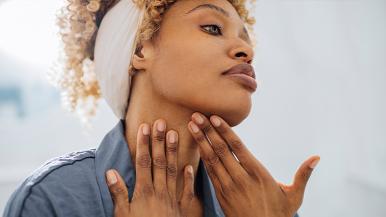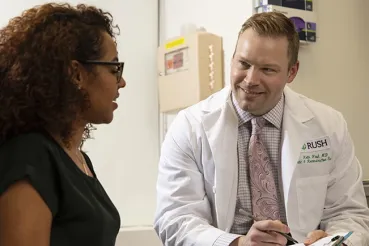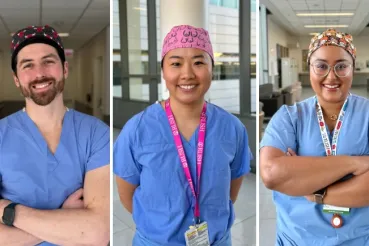Feeling a new lump or bump on or under your skin can be alarming … but not every bump is something to worry about.
We talked with Rush doctors about some of the common lumps and bumps their patients experience, along with the signs and symptoms that call for a visit to a specialist.
Location, location, location
If you notice a new bump, your first stop should be your primary care doctor's office.
An experienced physician has likely seen and felt thousands of the really common, harmless lumps and bumps, along with potentially rare or worrisome ones.
A lump or bump's location — along with how it looks and feels — is always the first clue as to what it might be and whether it's appropriate to refer the patient on to a specialist.
On your torso or neck
Feels like: A soft, movable bump just under your skin that’s not painful when touched.
Could be: A lipoma, a benign tumor in the fat cells under the skin. Lipomas can pop up anywhere on the body, but they're seen most commonly on the torso and neck.
Possible treatment: No need for treatment unless the lipoma causes discomfort or you feel it's unsightly and want to talk to a plastic surgeon about removing it. Lipomas do not become cancerous.
On your back, chest or shoulders
Feels like: A smooth, firm lump that's painless to the touch.
Could be: A sebaceous cyst (a small sac filled with sebum, the oily substance that moisturizes your hair and skin) or an epidermoid cyst (a lump containing skin cells and protein).
Possible treatment: None needed, unless the cyst gets bigger, becomes painful or starts draining. In that case, you might need antibiotics or an outpatient procedure to drain the cyst. Irresistible as it might be, never squeeze a cyst yourself; breaking the skin can lead to infection.
On your wrist, foot or ankle
Feels like: A soft, fluid-filled bump that doesn't move and might increase and decrease in size periodically.
Could be: A ganglion cyst, caused by a buildup of leaking joint fluid.
Possible treatment: Doctors typically leave these alone unless they become painful, interfere with joint function or are really unsightly, in which case they might refer the patient to a surgeon. The surgeon may drain the cyst with a needle or, if it's persistent, remove it surgically.
On your neck
Feels like: A tender lump under your jaw or behind your ear.
Could be: A swollen lymph node. Lymph nodes help filter toxins and fight infection, and it's normal for them to swell if you have a cold or a virus. Once you've recovered, a benign lymph node will shrink again. You also have lymph nodes in your armpits and groin.
Possible treatment: If a lymph node becomes painful, continues to swell or doesn't decrease in size after a short time, you may need tests to diagnose what's going on. Persistently swollen lymph nodes, especially when accompanied by other symptoms such as a cough, weight loss or fatigue, can be indicators of conditions like lung cancer or lymphoma, a cancer of the lymphatic system.
A lump or bump's location — along with how it looks and feels — is always the first clue as to what it might be and whether it's appropriate to refer the patient on to a specialist.
On your ear, lip, chest or anywhere else that’s exposed to the sun
Feels like: A small, pearly bump that resembles a mole or pimple.
Could be: Basal cell carcinoma, a slow-growing skin cancer caused by sun exposure.
Possible treatment: You'll likely be referred to a dermatologist for a biopsy, in which the doctor will take a small sample of the skin and send it to a lab for evaluation. Treatment will depend on the size and location of the carcinoma and might include surgery, radiation therapy and/or medication.
On your breast
Feels like: Anything from a rubbery, movable lump to a firm, fluid-filled sac to a solid, irregularly shaped bump. A monthly breast self-exam is the best way to get to know what’s normal for you and quickly spot any changes. A mammogram, as recommended by your doctor, is even better, because it can detect a lump before you can feel it.
Could be: A cyst or a solid tumor called a fibroadenoma; like 80% of breast lumps, these are benign. However, breast cancer can also show up as a lump, so it's important to see your doctor right away if you feel a new lump. Most, but not all, breast cancer lumps are not painful to the touch.
Possible treatment: If you're over 30, your primary care physician is likely to refer you for further evaluation immediately; follow-up could include a mammogram, ultrasound and/or biopsy. If you're in your teens or 20s, your doctor might advise you to wait a menstrual cycle or two to see if the lump goes away.
Get it checked
Even if you don't think a new lump or bump is worrisome, if you answer "yes" to any of the following questions, you should make an appointment with your primary care physician right away — no matter where your particular bump has popped up:
- Is the lump growing?
- Is the lump hard and immovable?
- Is the lump painful or tender to the touch?
- Is the lump red, itchy or inflamed?
It's true that most lumps and bumps are not cause for concern, but it's really important to have your doctor take a look. And it's just as important for primary care doctors to refer patients to specialists for further evaluation if there's any question about what a lump might be.




